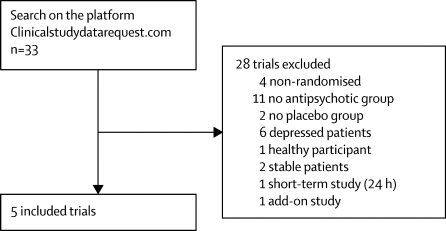The Lancet Psychiatry ( IF 64.3 ) Pub Date : 2017-09-19 , DOI: 10.1016/s2215-0366(17)30331-0 Myrto T Samara , Yair Goldberg , Stephen Z Levine , Toshi A Furukawa , John R Geddes , Andrea Cipriani , John M Davis , Stefan Leucht

|
Background
The efficacy of antipsychotics across the initial severity range in patients with acute mania remains unclear. Therefore, we examined the influence of baseline severity on the efficacy of olanzapine.
Methods
We did an individual participant data meta-analysis of double-blind, randomised controlled trials that compared olanzapine with placebo, identified through searches of the ClinicalStudyDataRequest.com database on Feb 2, 2016. We included patients with acute mania associated with bipolar I disorder. We examined the association between baseline and change scores on the Young Mania Rating Scale (YMRS; range 0–60) up to 3 weeks for olanzapine versus placebo groups using eight increasingly complex competing mixed-effects models for repeated measures.
Findings
We identified 33 reports, five (15%) of which were eligible and contained data for 939 patients (552 received olanzapine; 387 received placebo). The interaction between baseline severity and treatment was significant (β=0·22, 95% CI 0·05–0·39; p=0·013). The greater the baseline severity, the greater the magnitude of the differences between olanzapine and placebo was expected. The mean estimated YMRS scores were reduced at 3 weeks in both groups, but were greater with olazapine than placebo by 2·56 points for patients with a baseline score of 20–25 (9·26 for olanzapine vs 6·70 for placebo; effect size 0·35, 95% CI 0·11–0·60), by 4·74 points for a baseline score of 25–35 (14·25 vs 9·51; 0·58, 0·34–0·86), and by 8·01 points for a baseline score of 35–60 (21·72 vs 13·71; 0·70, 0·31–1·23).
Interpretation
Benefits of olanzapine can be expected for patients across the full spectrum of symptom severity who are likely to be treated for acute mania. Less severely ill patients seem to benefit less in terms of olanzapine efficacy, but still experience the same side-effects as more severely ill patients. Thus, clinicians and patients should carefully consider the benefit-to-risk ratio of olanzapine and its additional, prophylactic effect against relapse in the long term. The generalisability of these results to other antipsychotics, trial designs, and medical conditions remains to be established.
Funding
None.
中文翻译:

I型双相情感障碍的初始症状严重程度和奥氮平的疗效:一项来自五项安慰剂对照研究的个体参与者数据的荟萃分析
背景
尚不清楚在最初的严重程度范围内抗精神病药在急性躁狂症患者中的疗效。因此,我们检查了基线严重程度对奥氮平疗效的影响。
方法
我们对2016年2月2日通过ClinicalStudyDataRequest.com数据库的搜索确定的奥氮平与安慰剂进行的双盲,随机对照试验进行了一项单独的参与者数据荟萃分析。我们纳入了患有躁郁症的躁郁症患者。我们使用八种日益复杂的竞争混合效应模型进行重复测量,研究了奥氮平组与安慰剂组之间长达3周的年轻躁狂评分量表(YMRS;范围0-60)的基线与变化评分之间的关联。
发现
我们确定了33份报告,其中五份(占15%)符合条件,并包含939例患者的数据(552例接受奥氮平; 387例接受安慰剂)。基线严重程度与治疗之间的相互作用很显着(β= 0·22,95%CI 0·05-0·39; p = 0·013)。基线严重程度越高,olanzapine与安慰剂之间的差异预期越大。两组在第3周的YMRS平均估计值均降低,但是对于基线评分为20–25的患者,奥氮平比安慰剂要高2·56分(奥氮平为9·26 ,安慰剂为6·70;影响大小为0·35,95%CI为0·11–0·60),得到4·74分,基线得分为25–35(14·25与9·51; 0·58、0·34-0·86 ),并获得8·01分,基线得分为35–60(21·72 vs13·71;0·70、0·31–1·23)。
解释
奥氮平对所有可能出现急性躁狂的症状严重程度的患者均有望带来益处。重症患者似乎在奥氮平疗效方面获益较少,但仍与重症患者具有相同的副作用。因此,临床医生和患者应仔细考虑奥氮平的获益风险比及其长期预防复发的附加预防作用。这些结果对其他抗精神病药物,试验设计和医疗条件的普遍性仍有待确定。
资金
没有任何。



























 京公网安备 11010802027423号
京公网安备 11010802027423号